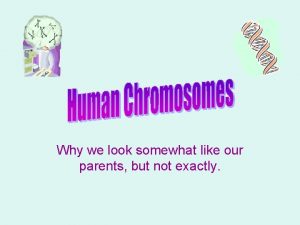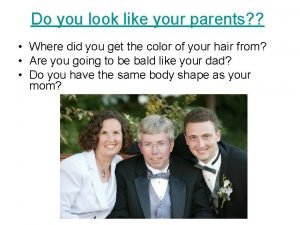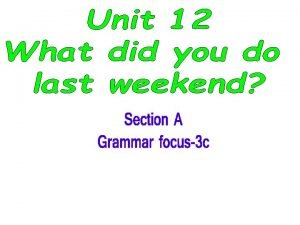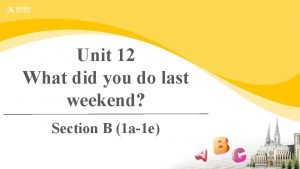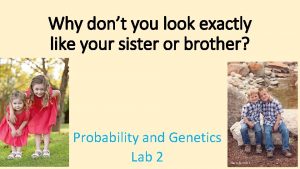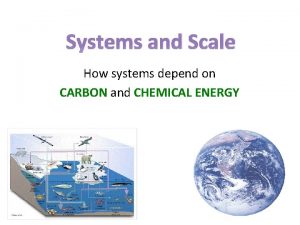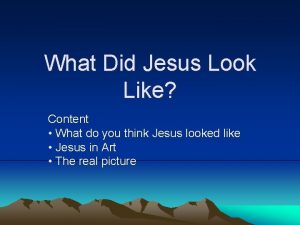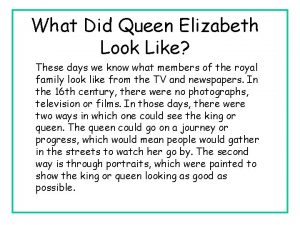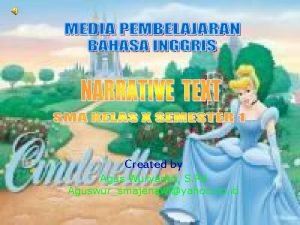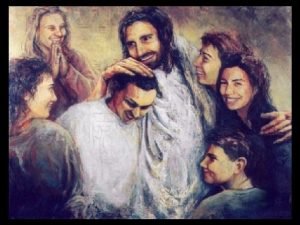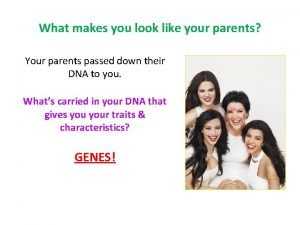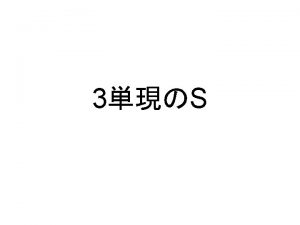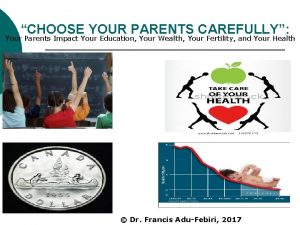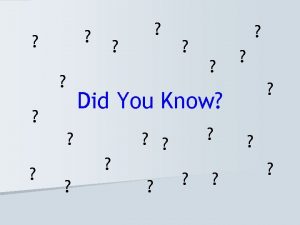Do you look like your parents Where did













- Slides: 13

Do you look like your parents? ? Where did you get the color of your hair from? Are you going to be bald like your dad? Do you have the same body shape as your mom?

• Our traits come from genes • Genes are found on chromosomes • Chromosomes are made of coiled up DNA

DNA • DNA is the genetic code or program of the cell, passed from generation to generation • - Different body cells of same organism contain same • amount of DNA except sex cells (sperm and egg)

Structure of DNA, polymer made of units called nucleotides. -Composed of: 1. sugar 2. phosphate 3. base.

Bases • • Adenine (A) Thymine (T) Guanine (G) Cytosine (C)

Rosalind Franklin purified and stretched DNA molecules, shot X - rays through strand recorded pattern on film Clues to structure of DNA * twisted like rope. * Large molecules spaced at regular intervals.

Watson and Crick attempted to make a three dimensional model of DNA molecule With Franklin's X - ray pattern Watson and Crick within weeks figured out the structure of DNA Their model was almost immediately accepted. Won 1962 Nobel prize (Watson, Crick, Wilkins, Franklin if alive).

According to legend, as they walked into the Eagle pub in Cambridge, Crick announced, "We have found the secret of life. "

Base Pairing

Base Pairing • A bonds to T • G bonds to C A-T G-C Question: What would the complementary strand be for the following sequence? TCAGCCACCTATGGA AGTCGGTGGATACCT

Mitosis and DNA Replication • Before a cell divides, DNA must be duplicated, so that each cell has an exact copy of the original DNA. This is called replication. – Takes place during interphase

Watson and Crick’s model provided a quick and easy way to see how DNA copies itself. The other half of a DNA strand is built through base pairing. Each half of the DNA strand is “complementary” or matching to the other. Ex. A T C C G T A A C T T G T A G G C A T T G A A C

Enzymes are involved in DNA replication. One enzyme "unzips" the two strands, like a pair of scissors. Another attaches the appropriate bases, like glue. We are then left with two copies of the DNA strand instead of one. • Other enzymes are involved in this process.
 Why do you look somewhat like your parents
Why do you look somewhat like your parents Left right look
Left right look What do your parents look like
What do your parents look like How did you .... your last weekend?
How did you .... your last weekend? What did you do during the weekend
What did you do during the weekend How _________ your last weekend?
How _________ your last weekend? You look like your sister
You look like your sister Which features of the sun look like huge cloud-like arches?
Which features of the sun look like huge cloud-like arches? Why does ethanol look like water but behave more like wood?
Why does ethanol look like water but behave more like wood? Went
Went What did jesus most likely look like
What did jesus most likely look like What did elizabeth i really look like
What did elizabeth i really look like Reorientation cinderella
Reorientation cinderella What did jesus look like
What did jesus look like
